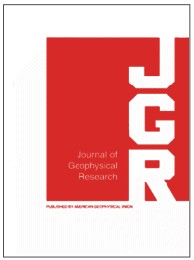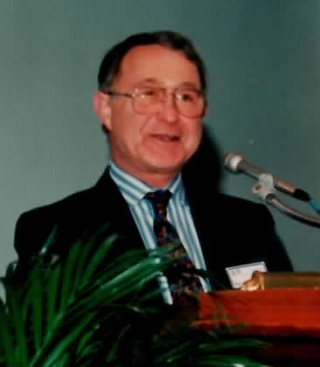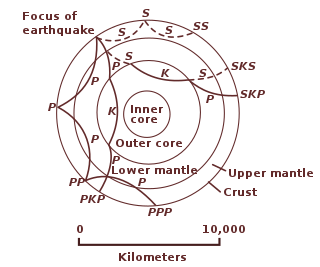Related Research Articles

The American Geophysical Union (AGU) is a 501(c)(3) nonprofit organization of Earth, atmospheric, ocean, hydrologic, space, and planetary scientists and enthusiasts that according to their website includes 130,000 people. AGU's activities are focused on the organization and dissemination of scientific information in the interdisciplinary and international fields within the Earth and space sciences. The geophysical sciences involve four fundamental areas: atmospheric and ocean sciences; solid-Earth sciences; hydrologic sciences; and space sciences. The organization's headquarters is located on Florida Avenue in Washington, D.C.
Allan Verne Cox was an American geophysicist. His work on dating geomagnetic reversals, with Richard Doell and Brent Dalrymple, made a major contribution to the theory of plate tectonics. Allan Cox won numerous awards, including the prestigious Vetlesen Prize, and was the president of the American Geophysical Union. He was the author of over a hundred scientific papers, and the author or editor of two books on plate tectonics. On January 27, 1987, Cox died in an apparent suicide.

The Journal of Geophysical Research is a peer-reviewed scientific journal. It is the flagship journal of the American Geophysical Union. It contains original research on the physical, chemical, and biological processes that contribute to the understanding of the Earth, Sun, and Solar System. It has seven sections: A, B, C (Oceans), D (Atmospheres), E (Planets), F, and G (Biogeosciences). All current and back issues are available online for subscribers.
Julius Bartels was a German geophysicist and statistician who made notable contributions to the physics of the Sun and Moon; to geomagnetism and meteorology; and to the physics of the ionosphere. He also made fundamental contributions to statistical methods for geophysics. Bartels was the first President of the International Association of Geomagnetism and Aeronomy (IAGA). With Sydney Chapman, he wrote the influential book Geomagnetism.

Edward A. "Ted" Irving, was a geologist and scientist with the Geological Survey of Canada. His studies of paleomagnetism provided the first physical evidence of the theory of continental drift. His efforts contributed to our understanding of how mountain ranges, climate, and life have changed over the past millions of years.
The Fred Whipple Award, established in 1989 by the Planetary Sciences Section of the American Geophysical Union, is presented to an individual who makes an outstanding contribution to the field of planetary science. The award was established to honor Fred Whipple. The Whipple Award includes an opportunity to present an invited lecture during the American Geophysical Union Fall Meeting.
The historical development of geophysics has been motivated by two factors. One of these is the research curiosity of humankind related to planet Earth and its several components, its events and its problems. The second is economical usage of Earth's resources and Earth-related hazards such as earthquakes, volcanoes, tsunamis, tides, and floods.
Louis John Lanzerotti is an American physicist. He is a Distinguished Research Professor of physics in the Center for Solar-Terrestrial Research at New Jersey Institute of Technology (NJIT) in Newark, New Jersey.

James Freeman Gilbert was an American geophysicist, best known for his work with George E. Backus on inverting geophysical data, and also for his role in establishing an international network of long-period seismometers.
George Edward Backus is an American geophysicist, best known for his work with J. Freeman Gilbert on inverse methods for geophysical data. He is also notably credited with advancing the dynamo theory on the origin of the Earth's magnetic field.

The following outline is provided as an overview of and topical guide to geophysics:

The history of geomagnetism is concerned with the history of the study of Earth's magnetic field. It encompasses the history of navigation using compasses, studies of the prehistoric magnetic field, and applications to plate tectonics.

Kathryn Anne "Kathy" Whaler OBE FRSE FAGU is a professor of geophysics at the University of Edinburgh School of GeoSciences, in the Research Institute of Earth and Planetary Science and is a member of the Solid Earth Geophysics and Natural Hazards Research Group.
Lisa Tauxe is a geophysicist, professor and former department chair at the Scripps Institution of Oceanography at UC San Diego. Tauxe is a researcher and international authority on the behavior of the ancient geomagnetic field and applications of paleomagnetism to geological problems.
Mioara Mandea is Head "Science Coordination" Department, Strategy Directorate at the Centre National d'Etudes Spatiales. She won the 2018 European Geosciences Union Petrus Peregrinus Medal and has previously served as their General Secretary. She is Officer, National Order of Merit (2023). She is best known for her work on geomagnetic jerks, sub-decadal changes in the Earth's magnetic field.
Catherine G. Constable is an Australian earth scientist who is a professor at the Scripps Institution of Oceanography. Her research considers palaeo- and geo-magnetism. Constable was awarded the American Geophysical Union William Gilbert Award in 2013 and elected Fellow of the American Association for the Advancement of Science in 2017.

Dennis V. Kent is an American geologist and geophysicist who is a Board of Governors Professor Emeritus at Rutgers University and an adjunct senior research scientist at Lamont–Doherty Earth Observatory of Columbia University. His research focuses on paleomagnetism, geomagnetism, rock magnetism, and their application to geologic problems, including geologic time scales, paleogeography, ancient climate, polar wander, and the long-term carbon cycle.
Subir Kumar Banerjee is an Indian-American geophysicist, known for research on rock magnetism, palaeomagnetism, and environmental magnetism.
References
- ↑ AGU Geomagnetism and Paleomagnetism Honors Program, retrieved 17 Sep 2014
- ↑ William Gilbert Award recipients retrieved 15 April 2020
- ↑ de Groot Receives 2018 William Gilbert Award retrieved 25 June 2019
- ↑ retrieved 28 July 2017
- ↑ Shaar Receives 2016 William Gilbert Award, retrieved 28 November 2016
- ↑ Jackson Receives 2015 William Gilbert Award, retrieved 29 Feb 2016
- ↑ Swanson-Hysell Receives 2014 William Gilbert Award, retrieved 29 Feb 2016
- ↑ Constable Receives 2013 William Gilbert Award, retrieved 17 Sep 2014
- ↑ Kopp Receives 2012 William Gilbert Award, retrieved 17 Sep 2014
- ↑ Kirschvink Receives 2011 William Gilbert Award, retrieved 17 Sep 2014
- ↑ Stanley Receives 2010 William Gilbert Award, retrieved 17 Sep 2014
- ↑ Dennis Kent Receives 2009 William Gilbert Award, retrieved 17 Sep 2014
- ↑ Lagroix Receives 2008 William Gilbert Award, retrieved 17 Sep 2014
- ↑ Coe Receives 2007 Gilbert Award, retrieved 17 Sep 2014